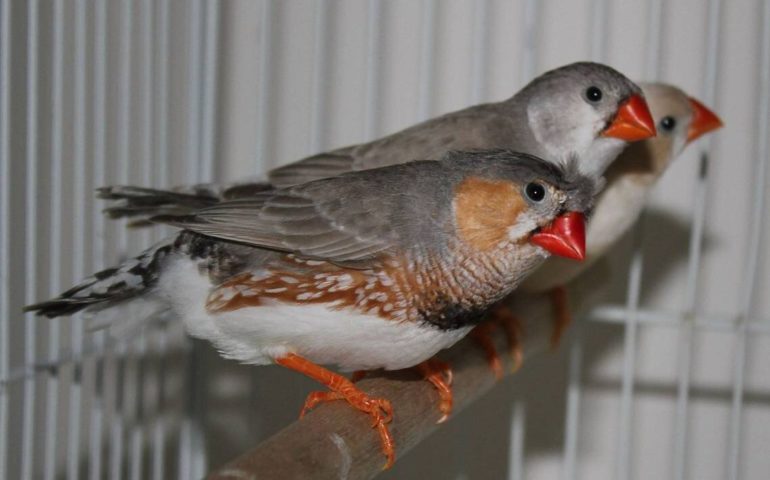Just as a professional athlete or concert pianist practices daily to hone and refine their physical movements for the best possible performance when it really counts, male zebra finches noodle around and sing slight variations of their courtship calls for most of their waking hours.
But when the game is on the line—specifically, when an attractive female zebra finch alights nearby—it’s go-time and the male bird will execute his song with practiced precision and speed.
Now, thanks to several new tools, including the ability to monitor a hundred neurons at once and some powerful machine learning analyses, neuroscientists at Duke University have seen the circuitry of the brain that controls the bird’s practice sessions and his performance.
The takeaway: At ‘game time,’ a squirt of the neurotransmitter noradrenaline in the basal ganglia, a region of the forebrain that governs complex movement in all vertebrates, shuts down the variability in the song and makes it as true to the ideal as it can be. The findings appear in Nature on Oct. 20.
When birds are singing for themselves, these basal ganglia neurons allow a certain amount of variability in the song, which the researchers say is essential to ‘mapping’ the circuitry and finding the optimal way to produce the song.
“To figure out how to move, it needs to first try out many different movements, to try out different ways of accomplishing a goal of moving their body,” said Jonna Singh Alvarado, who led this project for his Ph.D. dissertation at Duke. “They need to learn, ‘If I think this, how am I about to move? How will that move my body?’ and it needs to do that in many variations.”
Having done the task many times, “you’ve established this kind of brain-to-movement dictionary, where you’ve explored all these different ways that you can give commands and they can move your body,” said Alvarado, who is now a post-doctoral researcher at Harvard University. “And then, you can exploit the mapping you’ve created. ‘I’ve explored, I have this dictionary, let me grab the right words from this dictionary and perform exactly what I know I can perform, given what I know the female wants to hear.’ “
Lots of practice is essential to keep the song in good shape, Alvarado said. “If they don’t keep polishing these circuits with constant activity, they slowly drift and degrade. Practicing and continuing to explore this vocal space and keeping your dictionary updated is very important to keep the performance at tip top shape.”
The differences between the practice songs and the courtship performances are super-subtle to human observers, almost undetectable, said Richard Mooney, the George Barth Geller professor of neurobiology in Duke’s School of Medicine and Alvarado’s thesis advisor. But the female zebra finches can tell, and they like a fast performance. A practice song played on a speaker fails to intrigue, but a swift and precise game-time song makes her check out the source of the sweet sounds.
“Songbirds have made this problem more simple for us,” Alvarado said. In the dedicated and specialized song circuitry of the bird’s basal ganglia, each neuron just does one job.
But even this relatively simple brain posed a huge computational problem for the team.
“One of the things that’s been really hard in other animals is to figure out what the link is between the variability you’re producing, and the variability you want to produce,” said John Pearson, an assistant professor of biostatistics and bioinformatics at Duke, who led the statistical analysis of the neurons. “This is the first time that people have gotten a real sizable population of these cells, and we can begin to try to link the variability in vocal performance to the variability in neural activity.”
Mooney, who describes himself as a huge fan of guitarist Jimi Hendrix, said he has heard this kind of rehearsal in Hendrix’s informal four-track living room tapes. “It kind of goes everywhere, there’s the kernel of one song, but then it sort of morphs. It’s like free jazz or something. And, you know, I think he was just really, really good at exploring when he was alone.”
This kind of motor rehearsal applies to any skill that’s being practiced, Alvarado said. “But then, there’s a moment in which you have to execute in a high-stakes situation—that can be something like predation, either escaping predator or catching prey, and it can be courtship: it’s time to perform and we need to do it in a very specific way that we know the other party is listening.”
Mooney, who has studied bird song for decades, said this work drew on many different kinds of scientific expertise, including colleagues at UC Berkeley and the University of Oregon. “It took a lot of different people to get all these parts worked out. It’s a big, very complex story.”
But the work is important because insight into the bird’s basal ganglia has direct relevance to human movement disorders, including Parkinson’s and Huntington’s diseases, Tourette’s syndrome, and others, Mooney said.
“In Parkinson’s, motor variability is dysfunctional and completely dysregulated and that is through the degeneration of these same basal ganglia circuits,” Alvarado said. “Understanding how (basal ganglia neurons) function normally and how their activity gets changed and rewired to produce completely different patterns of movement is pretty paramount to understanding just how to fix these problems in the future,” he said.
Song-learning neurons identified in songbirds
More information:
Richard Mooney, Neural dynamics underlying birdsong practice and performance, Nature (2021). DOI: 10.1038/s41586-021-04004-1
Citation:
Neuroscientists see how practice really does make perfect (2021, October 21)
retrieved 21 October 2021
from https://phys.org/news/2021-10-neuroscientists.html
This document is subject to copyright. Apart from any fair dealing for the purpose of private study or research, no
part may be reproduced without the written permission. The content is provided for information purposes only.



